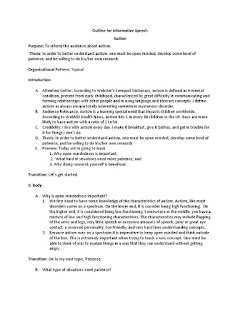Informative Speech Outline on Autism
Autism is a neurodevelopmental disorder that affects communication and social interaction. It is characterized by repetitive behaviors, difficulties with verbal and non-verbal communication, and challenges in social interaction.
I. Definition and Types of Autism
1. Definition: Autism, also known as Autism Spectrum Disorder (ASD), refers to a range of conditions that impact social skills, communication, and behavior. It is a lifelong condition that affects individuals differently.
2. Types of Autism: There are various types of autism, including:
- Autistic disorder (classic autism)
- Asperger syndrome
- Pervasive Developmental Disorder-Not Otherwise Specified (PDD-NOS)
- Childhood Disintegrative Disorder
II. Signs and Symptoms
1. Social Interaction: Individuals with autism may have difficulties with:
- Maintaining eye contact
- Understanding social cues and body language
- Taking turns in conversation
2. Communication: Autism affects both verbal and non-verbal communication skills, such as:
- Delayed language development
- Echolalia (repeating words or phrases)
- Difficulty starting or maintaining a conversation
3. Repetitive Behaviors: Individuals with autism often engage in repetitive actions, including:
- Hand-flapping or spinning
- Obsessive interests and routines
- Sensory sensitivities
III. Causes and Risk Factors
1. Genetic Factors: Studies have shown that genetic factors play a role in the development of autism. Certain genes can increase the risk of autism, but it is not solely determined by genetics.
2. Environmental Factors: Prenatal and early childhood environmental factors, such as exposure to certain chemicals or infections, may contribute to the development of autism.
IV. Diagnosis and Treatment
1. Diagnosis: Autism is usually diagnosed in early childhood based on behavioral observations and evaluations conducted by healthcare professionals.
2. Treatment: While there is no cure for autism, early intervention and therapy can help manage symptoms and improve quality of life. Treatment options may include:
- Behavioral therapy
- Speech and language therapy
- Occupational therapy
- Medication, if necessary for associated conditions
V. Support and Resources
1. Support for Individuals with Autism: There are various support services available for individuals with autism, including:
- Support groups
- Vocational programs
- Assistive technology
2. Resources for Families: Families of individuals with autism can benefit from resources such as:
- Educational programs
- Parent training and counseling
- Respite care services
Conclusion
Autism is a complex disorder that affects individuals in unique ways. By understanding the different aspects of autism, its signs and symptoms, as well as available support and resources, we can create a more inclusive and supportive environment for individuals with autism.

No comments:
Post a Comment